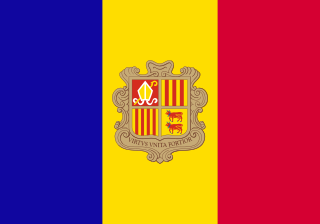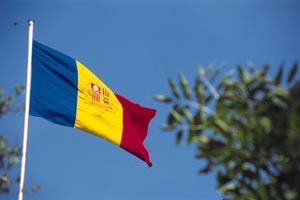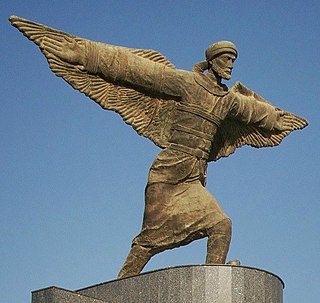1970s in Andorra:
1970s in Andorra:

Andorra, officially the Principality of Andorra, is a sovereign landlocked country on the Iberian Peninsula, in the eastern Pyrenees, bordered by France to the north and Spain to the south. Believed to have been created by Charlemagne, Andorra was ruled by the count of Urgell until 988, when it was transferred to the Roman Catholic Diocese of Urgell. The present principality was formed by a charter in 1278. It is currently headed by two co-princes: the bishop of Urgell in Catalonia, Spain and the president of France. Its capital and largest city is Andorra la Vella.

Year 622 (DCXXII) was a common year starting on Friday of the Julian calendar, the 622nd year of the Common Era (CE) and Anno Domini (AD) designations, the 622nd year of the 1st millennium, the 22nd year of the 7th century, and the 3rd year of the 620s decade. The denomination 622 for this year has been used since the early medieval period, when the Anno Domini calendar era became the prevalent method in Europe for naming years.

Andorra la Vella is the capital and largest city of Andorra. It is located high in the east Pyrenees, between France and Spain. It is also the name of the parish that surrounds the capital.

"El gran Carlemany" is the national anthem of the Principality of Andorra. Enric Marfany Bons composed the music, while the lyrics were authored by Joan Benlloch i Vivó, written in a first-person narrative from the point of view of Andorra. It was adopted as the national anthem on 8 September 1921, which is also the national day of Andorra. The lyrics make reference to several key aspects of Andorran culture and history, such as the heritage of the Carolingian Empire.

The coat of arms of Andorra is the heraldic device consisting of a shield divided quarterly by the arms of the Bishop of Urgell and the Count of Foix – who have historically been the two co-princes of Andorra – in addition to the emblems of Catalonia and the Viscount of Béarn. Utilized unofficially since the Middle Ages, its status as the coat of arms of the Principality of Andorra was formalized in 1993 upon the implementation of their new constitution. The escutcheon is featured on the flag of Andorra.

Canillo is one of the parishes of Andorra. Canillo is also the name of the main town of the parish. The parish is considered the religious center of Andorra with the Sanctuary and Chapel of Our Lady of Meritxell, patron saint of Andorra, and contains one of the best-preserved romanesque churches in the Pyrenees, Sant Joan de Caselles. It has a population of 4,826, as of 2011. Despite having a tourist vocation, the parish of Canillo still retains many livestock and agricultural traits. It borders France.

Boris Mikhailovich Skossyreff was a Belarusian adventurer, international swindler and pretender who attempted to seize the monarchy of the Principality of Andorra during the early 1930s, styling himself King Boris I of Andorra.

Abu al-Qasim Abbas ibn Firnas ibn Wirdas al-Takurini, known as Abbas ibn Firnas was an Andalusi polymath: an inventor, astronomer, physician, chemist, engineer, Andalusi musician, and Arabic-language poet. He was reported to have experimented with unpowered flight.

Lobamba is a city in Eswatini, and is one of the two capitals, serving as the legislative, traditional, spiritual, seat of government of the Parliament of Eswatini, and Ludzidzini Royal Village, the residence of Queen Ntfombi, the Queen Mother.

Lebanese cuisine is the culinary traditions and practices originating from Lebanon. It includes an abundance of whole grains, fruits, vegetables, fresh fish and seafood. Poultry is eaten more often than red meat, and when red meat is eaten, it is usually lamb and goat meat. Dishes include copious amounts of garlic and olive oil, and dishes are often seasoned with lemon juice. Chickpeas and parsley are also staples of the Lebanese diet.

Coma Pedrosa is the highest mountain in the principality of Andorra. It is popular with mountain climbers, its ascent being technically straightforward, although strenuous. From Arinsal to Camp de Refuge is considered moderate meanwhile the last 862 m is considered to be difficult. Several mountain lakes and tarns are found on the slopes, notably Estanys de Baiau, which lies on the western slopes, across the Spanish border.
In Greek mythology, Paean, Paeëon or Paieon (Παιήων), or Paeon or Paion (Παιών) was the physician of the gods.
This is a list of events related to architecture in the 1230s.
Kombe people are an African ethnic group, members of the Bantu group, who are indigenous to Equatorial Guinea. They are native speakers of the Kombe language.
San Marino is a small landlocked country with an area of about 61.2 km2 (23.6 sq mi) on a rocky promontory at an elevation of 657 meters (2,156 ft) in central Italy. In 2023, the population was 33,636. It is the third smallest country in Europe after Vatican City and Monaco. It is traditionally held to have been founded as a republic in 301 AD, was recognized by the Papacy in 1631, and became a member of the United Nations in 1992. As of 2009, the ethnic composition was about 84.95% Sammarinese, 14.6% Italians and others.

Lake Engolasters, in the Encamp parish of Andorra, is an oblong shaped lake at an elevation of 1,616 m (5,302 ft). formed in a glacial depression. It is located close to Andorra La Vella, the capital of Andorra.

Andorra and Spain are members of the Council of Europe, Organization of Ibero-American States and the United Nations.
This is a list of encyclopedias and encyclopedic/biographical dictionaries published on the subject of geography and geographers in any language. Entries are in the English language except where noted.

The National Archives of Andorra was established in 1975 under the direction of historian and civil servant Lídia Armengol i Vila.
The law of Andorra includes customary law and legislation.